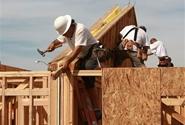Steel Markets

Construction Spending Steady in August Says AGC
Written by Sandy Williams
October 4, 2016
Construction sector recovery may be at a plateau, says Stephen Sandherr , CEO of the Associated General Contractors of America. The press release from AGC for August construction spending follows:
Construction spending held steady in August compared to July but is up nearly five percent for the first eight months of the year compared to same period in 2015, according to an analysis by the Associated General Contractors of America. Association officials said the new spending figures indicates that the industry’s recovery may be at risk and said new investments in the nation’s aging water systems and other infrastructure could help offset declining spending in certain types of private construction.
“While demand for construction remains robust, it is no longer growing like it was earlier this year,” said Ken Simonson, the association’s chief economist. “There is little doubt that new public-sector investments in our aging infrastructure could help reinvigorate demand for construction.”
Construction spending in August totaled $1.142 billion at a seasonally adjusted annual rate, essentially unchanged from the month before, Simonson said. He added that the year-to-date increase of 4.9 percent for January through August 2016, compared with the same months of 2015, shows that demand for construction projects remains relatively robust despite some recent monthly declines. But he cautioned that the month-to-month figures indicate that demand for construction is no longer growing like it was earlier this year.
Private nonresidential construction spending decreased 0.4 percent for the month but is up 4.2 percent year-to-date. The largest private nonresidential segment in August was power construction (including oil and gas pipelines), which declined 1.5 percent for the month but up 2.9 percent year-to-date. The next-largest segment, manufacturing, dropped by 1.4 percent for the month and is down 7.4 percent year-to-date. Commercial (retail, warehouse and farm) construction decreased by 2 percent in August and climbed 6.9 percent year-to-date. Private office construction climbed 2.3 percent for the month and 28 percent year-to-date.
Private residential construction spending dropped by 0.3 percent between July and August 2016, but is up 1.4 percent year-to-date. Spending on multifamily residential construction increased by 2.4 percent for the month and remains up 13.9 percent year-to-date, while single-family spending fell 0.9 percent from July to August and is down 1.5 percent year-to-date.
Public construction spending declined 2 percent from a month before and dropped by 8.8 percent year-to-date. The biggest public segment—highway and street construction—decreased by 2.9 percent for the month and is down 8.3 percent year-to-date. The other major public category—educational construction—fell by 0.4 percent in August and dropped 0.8 percent year-to-date.
Association officials said that the new construction spending figures underscore the need for Congress to pass legislation like the Water Resources Development Act to finance repairs to aging water systems. The said that measure, combined with other needed investments in public infrastructure could help offset declining private sector demand and re-invigorate the construction sector’s recovery.
“The construction industry’s recovery appears to have hit a plateau,” said Stephen E. Sandherr, the association’s chief executive officer. “The sector is at the point where new public-sector investments could really help take up the slack being left by declines in some types of private-sector construction activity.”

Sandy Williams
Read more from Sandy WilliamsLatest in Steel Markets

CRU: Sheet import demand softens as domestic price gains have slowed
US domestic sheet price gains have begun to slow as previously pulled-forward demand has led to a decline in orders.

CMC looks beyond Arizona micro-mill woes to long-term viability of construction mart
Despite the economic and geopolitical upheaval of the last five years, CMC President and CEO Peter Matt points out that the construction market has been an essential element of the way forward.

US importers face stricter rules under revamped S232 tariffs
“CBP expects full compliance from the trade community for accurate reporting and payment of the additional duties. CBP will take enforcement action on non-compliance," the agency said in a March 7 bulletin.

Steel exports rebound in January
US steel exports recovered to a five-month high in January after having fallen to a two-year low in December. This growth follows four consecutive months of declining exports.

Construction spending drops marginally in January
Construction spending edged down slightly in January, slipping for the first time in four months. The US Census Bureau estimated spending at a seasonally adjusted annual rate of $2,196 billion in January, down 0.2% from December’s downward revised rate. The January figure is 3.3% higher than a year ago. January’s result, despite the slight erosion, […]
